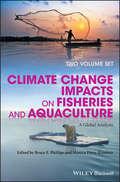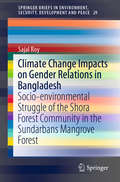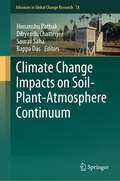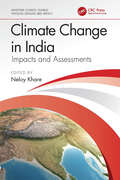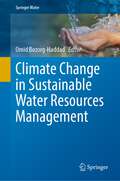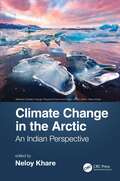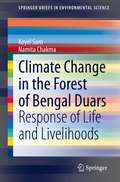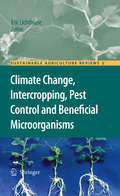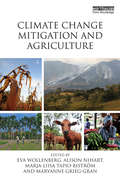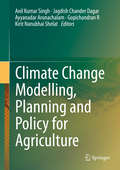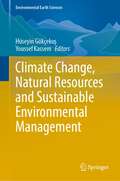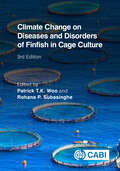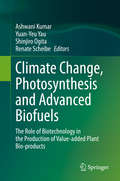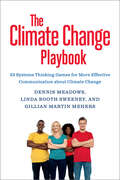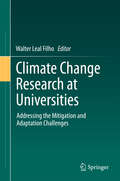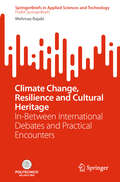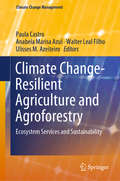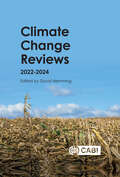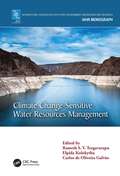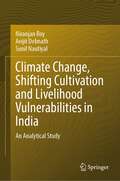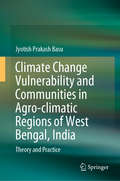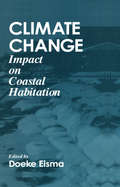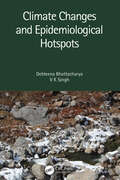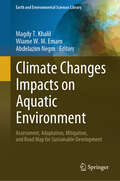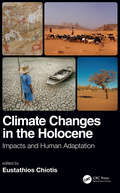- Table View
- List View
Climate Change Impacts on Fisheries and Aquaculture: A Global Analysis
by Bruce F. Phillips M¿nica P¿rez-Ram¿rezThe first comprehensive review of the current and future effects of climate change on the world’s fisheries and aquaculture operations The first book of its kind, Climate Change Impacts on Fisheries and Aquaculture explores the impacts of climate change on global fisheries resources and on marine aquaculture. It also offers expert suggestions on possible adaptations to reduce those impacts. The world's climate is changing more rapidly than scientists had envisioned just a few years ago, and the potential impact of climate change on world food production is quite alarming. Nowhere is the sense of alarm more keenly felt than among those who study the warming of the world's oceans. Evidence of the dire effects of climate change on fisheries and fish farming has now mounted to such an extent that the need for a book such as this has become urgent. A landmark publication devoted exclusively to how climate change is affecting and is likely to affect commercially vital fisheries and aquaculture operations globally, Climate Change Impacts on Fisheries and Aquaculture provides scientists and fishery managers with a summary of and reference point for information on the subject which has been gathered thus far. Covers an array of critical topics and assesses reviews of climate change impacts on fisheries and aquaculture from many countries, including Japan, Mexico, South Africa, Australia, Chile, US, UK, New Zealand, Pacific Islands, India and others Features chapters on the effects of climate change on pelagic species, cod, lobsters, plankton, macroalgae, seagrasses and coral reefs Reviews the spread of diseases, economic and social impacts, marine aquaculture and adaptation in aquaculture under climate change Includes special reports on the Antarctic Ocean, the Caribbean Sea, the Arctic Ocean and the Mediterranean Sea Extensive references throughout the book make this volume both a comprehensive text for general study and a reference/guide to further research for fisheries scientists, fisheries managers, aquaculture personnel, climate change specialists, aquatic invertebrate and vertebrate biologists, physiologists, marine biologists, economists, environmentalist biologists and planners.
Climate Change Impacts on Gender Relations in Bangladesh: Socio-environmental Struggle of the Shora Forest Community in the Sundarbans Mangrove Forest (SpringerBriefs in Environment, Security, Development and Peace #29)
by Sajal RoyThis book explores gendered perceptions of the Sundarbans Forest in Bangladesh, and the extent to which these perceptions are affected by extreme weather events (specifically, cyclones Aila and Sidr). Based on ethnographic fieldwork in Shora, a rural village in southern Satkhira, Bangladesh, the book explores gendered activities in the forest, especially women’s interaction with the forest resources. The findings present a clear picture of the Shora community’s local knowledge about the Sundarbans Forest, as well as the ecological and economic contributions for the forest people. The book makes a timely contribution to the wider study of gender, post-cyclone recovery, ecology and resilience.
Climate Change Impacts on Soil-Plant-Atmosphere Continuum (Advances in Global Change Research #78)
by Himanshu Pathak Dibyendu Chatterjee Saurav Saha Bappa DasThis book explores the interaction between climate change phenomena and the soil–plant–atmosphere continuum (SPAC), which inspects the crucial role of anthropogenic greenhouse gas emissions in modifying the net ecosystem response towards the modified environment. Increasing concentration of anthropogenic greenhouse gases (carbon dioxide, methane and nitrous oxide) from massive deforestation, fossil fuel burning and rapid industrialization in the post-nineteenth century have led to adverse changes in our global climate system. The book evaluates the net impact of climate change on soil, plants and the atmosphere individually and in totality. Among the topics it covers are the impact of climate change on soil environment which encompasses soil processes, nutrient cycling, soil carbon sequestration, soil biota response and soil health management. Also included are the impact on plants with respect to the dry matter assimilation pattern, modification in resource use efficiency, rhizosphere interactions, management of biotic and abiotic stress factors, and regulatory mechanisms of biotic stress factors in modifying the net agroecosystem response towards climate change. Moreover, potential genetic engineering options for establishing C4 or Crassulacean acid metabolism (CAM) in C3 plants, heat–drought stress on pollen biology, breeding ideotype, ecological indicators and crop simulation modelling are considered. Lastly, the impact on the atmosphere takes into account greenhouse gas measurements, mitigation options, eddy covariance measurement of greenhouse gasses, satellite-based monitoring, ecosystem services, abiotic stress management options, air pollution and atmospheric modelling. This book is a valuable resource for researchers, students and policymakers in understanding climate change impacts on interaction processes among the atmosphere, soil and plants from the local to regional scales.
Climate Change in India: Impacts and Assessments (Maritime Climate Change)
by Neloy KhareThe climate over the Indian subcontinent is influenced by complex interactions between the atmosphere, ocean, and land, along with human interventions that are influencing heat extremes, changing monsoon patterns, sea-level rise, and posing serious threats to lives and livelihoods among populations in India. This book, based on recent studies and research, explains how and why the climate is changing across India and how these changes are expected to evolve in the future. It takes a holistic view of the climate from India’s perspective and discusses important themes such as groundwater, land use, livestock, and natural disasters. Readers will have an in-depth understanding of impacts and possible adaptations.Features Includes case studies of groundwater and the effect of climate change. Identifies land use and land cover changes in different regions in India. Discusses the implications of past and present climate change on various livestock types. Explains various natural hazards and their relationship to climate change. Describes technological intervention in climate change. Researchers, academics, and graduate students in Earth sciences, climatology, meteorology, or environmental studies working on projects related to climate change will find this an invaluable reference. Governmental organizations, institutions, and global NGOs will also benefit from the insights presented in this book.
Climate Change in Sustainable Water Resources Management (Springer Water)
by Omid Bozorg-HaddadThis book provides a comprehensive approach to all aspects of water-related subjects affected by climate change that expand readers' attitudes toward future of the management strategies and improve management plans. It summarizes climate change scenarios, models, downscaling methods, and how to select the appropriate method. It also introduces practical steps in assessing climate change impacts on water issues through introducing hydrological models and climate change data applications in hydrologic analysis. The book caters to specialist readers who are interested in analyzing climate change effects on water resources, and related issues can gain a profound understanding of the practical concepts and step-by-step analysis, which is enriched with real case studies all around the world. Moreover, readers will be familiar with potential mitigation and adaptation measures in sustainable water engineering, considering the results of hydrologic modeling.
Climate Change in the Arctic: An Indian Perspective
by Neloy KhareThe Arctic, in the polar region, the northernmost part of Earth, is the hotspot for climate change assessments and the sensitive barometer of global climate variability. This book includes the scientific observations in the Arctic region’s climate and the results obtained by scientists at the Indian Arctic station Himadri over the past decade. Designed and structured to incorporate multi-dimensional climate change research output, it is a significant contribution toward understanding, among other issues, the role of persistent organic pollutants and mercury, as well as the increase of carbon monoxide during ozone reduction in the Arctic. Features include: Highlights the achievements of climate change research in the Arctic region Includes case studies of scientists in the Arctic and their significant achievements through the Indian research base Himadri Provides a thorough review of palaeoclimate change studies, the impact of climate change on biotic components and the impact of climate change on abiotic components Provides specific details on the study of ozone depletion phenomenon over the Arctic region Covers a wide range of research contributions Details sea ice variability in the context of global warming over the Arctic region Connects seismogenesis with the climate change in the Arctic region This book will be an important read for researchers, students and all interested professionals.
Climate Change in the Forest of Bengal Duars: Response of Life and Livelihoods (SpringerBriefs in Environmental Science)
by Koyel Sam Namita ChakmaThis book focuses on more than 100 years of climatic oscillation in Bengal Duars, a unique foothill landscape of the Eastern Himalaya, to discuss the dynamics of life and livelihoods of forest dependent communities towards climate change related impacts. The authors describe the struggles the people of this region face, including climate vulnerability, displacement, migration, and human-animal conflict, and provides a unique and comprehensive analysis of the interconnection between perceptions and responses of forest villagers for survival and adaptation to climate change. The book presents advanced quantitative methods and field-based studies applied in the region to help researchers and policy makers comprehend and measure potential and actual adaptation attitudes of the villagers, while also understanding the present challenges, risk patterns, and potential impacts climate change has on the natural environment and community life. The book will additionally be of interest to students and researchers in geography, forestry, ecology and environmental science.
Climate Change, Intercropping, Pest Control and Beneficial Microorganisms (Sustainable Agriculture Reviews #2)
by Eric LichtfouseSustainable agriculture is a rapidly growing field aiming at producing food and energy in a sustainable way for humans and their children. Sustainable agriculture is a discipline that addresses current issues such as climate change, increasing food and fuel prices, poor-nation starvation, rich-nation obesity, water pollution, soil erosion, fertility loss, pest control, and biodiversity depletion. Novel, environmentally-friendly solutions are proposed based on integrated knowledge from sciences as diverse as agronomy, soil science, molecular biology, chemistry, toxicology, ecology, economy, and social sciences. Indeed, sustainable agriculture decipher mechanisms of processes that occur from the molecular level to the farming system to the global level at time scales ranging from seconds to centuries. For that, scientists use the system approach that involves studying components and interactions of a whole system to address scientific, economic and social issues. In that respect, sustainable agriculture is not a classical, narrow science. Instead of solving problems using the classical painkiller approach that treats only negative impacts, sustainable agriculture treats problem sources. Because most actual society issues are now intertwined, global, and fast-developing, sustainable agriculture will bring solutions to build a safer world. This book series gathers review articles that analyze current agricultural issues and knowledge, then propose alternative solutions. It will therefore help all scientists, decision-makers, professors, farmers and politicians who wish to build a safe agriculture, energy and food system for future generations.
Climate Change Mitigation and Agriculture
by Eva Wollenberg Alison Nihart Marja-Liisa Tapio-Biström Maryanne Grieg-GranThis book reviews the state of agricultural climate change mitigation globally, with a focus on identifying the feasibility, opportunities and challenges for achieving mitigation among smallholder farmers. The purpose is ultimately to accelerate efforts towards mitigating land-based climate change. While much attention has been focused on forestry for its reputed cost-effectiveness, the agricultural sector contributes about ten to twelve per cent of emissions and has a large technical and economic potential for reducing greenhouse gases. The book does not dwell on the science of emissions reduction, as this is well covered elsewhere; rather, it focuses on the design and practical implementation of mitigation activities through changing farming systems. Climate Change Mitigation and Agriculture includes chapters about experiences in developed countries, such as Canada and Australia, where these efforts also have lessons for mitigation options for smallholders in poorer nations, as well as industrialising countries such as Brazil and China. A wide range of agroecological zones and of aspects or types of farming, including livestock, crops, fish farming, fertilizer use and agroforestry, as well as economics and finance, is included. The volume presents a synthesis of current knowledge and research activities on this emerging subject. Together the chapters capture an exciting period in the development of land-based climate change mitigation as attention is increasingly focused on agriculture's role in contributing to climate change.
Climate Change Modelling, Planning and Policy for Agriculture
by Jagdish Chander Dagar Anil Kumar Singh Ayyanadar Arunachalam Gopichandran R Kirit Nanubhai ShelatIt is well known that the impacts of climate change are tangible and hence there can be no debate about the need for appropriate adaptation measures, on a priority basis. However, it is equally important to recognize the fact that adaptation measures actually represent a dynamic synthesis of interventions pertaining to multiple systems. These are particularly of water, soil characteristics, genotypic and phenotypic variations and their expressions, age-correlated biochemical changes aligned with planting schedules and favorable weather/climate conditions. Nutrients, occurrence and distribution of associated vegetation including crop mixes also influence productivity. The overarching aspect of farming practice wields significant influence on the outcome and hence it is important to be clear about the particular focus of the investigations being carried out and reported in a suitable manner. It is essential to recognize that scientific research in agriculture in India has always produced valuable results of direct relevance to her people. Importantly, preparedness to tackle disasters due to inclement weather system has prominently featured on the agenda. The recent focus on climate change and impacts has provided the necessary impetus to reorganize the framework of investigation to capture the specifics of such impacts. In this context, the importance of micro climate variations too viz-a-viz the larger scales of impacts cannot be overemphasized. It will be useful to also help characterize natural variations versus artificially induced variations, helping us understand the complexities of individual and synergistic impacts too. Obviously, the limits and limitations of models could determine the spread and depth of the outcomes of investigations. Empirical evidences to reinforce assumptions have to also be documented with utmost care; guided by an understanding of the limits of tolerance, limiting factors, and the precautionary principle especially in the public policy interface. The present volume therefore, showcases these strands with the fond hope that they will stimulate further thinking and enable appropriate action.
Climate Change, Natural Resources and Sustainable Environmental Management (Environmental Earth Sciences)
by Hüseyin Gökçekuş Youssef KassemThis book is a compilation of selected papers from the Fifth International Conference on Natural Resources and Sustainable Environmental Management held in Near East University, November 2021. It provides intellectual guidance and scientific evidence on the challenges of global warming and climate change based on a humanistic and critical thinking approach, promoting research and education to build equality in the global community and more sustainable societies. This book also addresses the current challenges of bridging the gap between government policymakers and providers of science and solutions with innovative ideas and new visions to help resolve the challenges facing us in the area of natural resources (water, energy), and environment.
Climate Change on Diseases and Disorders of Finfish in Cage Culture
by Patrick T.K. Woo Rohana P. SubasingheThis, the third volume in the series Climate Change and Fish Health, describes how finfish in cage culture and their pathogens are directly or indirectly affected by ongoing changes to the environment. These changes, which include a global rise in water temperature with increased acidification and reduction in dissolved oxygen, will continue even if we can significantly reduce the current output of anthropogenic carbon dioxide and methane. The third edition of Diseases and Disorders of Finfish in Cage Culture has been renamed to be included in the series, and is completely updated and revised. It has: · Nine updated chapters with new expert contributions from around the world · A focus on the effects that climate change has, and will have, on finfish and their pathogens · New material includes chapters on algal blooms, biosecurity and fish welfare · An emphasis on practical recommendations and changes that can be made to improve fish health This book is key reading for all involved in cage culture of finfish, research scientists, ecologists, fish health consultants, veterinarians, policy makers and all who are interested in fish health and changes to the environment. It is a good reference text for 'workshops on fish health' and academic courses such as aquaculture and fish health.
Climate Change, Photosynthesis and Advanced Biofuels: The Role of Biotechnology in the Production of Value-added Plant Bio-products
by Ashwani Kumar Yuan-Yeu Yau Shinjiro Ogita Renate ScheibeThe use of fossil fuels results in rising CO2 and other greenhouse gas (GHG) emissions, causing global temperature rise and climate change that will negatively impact human health, the food supply, and eventually worsen hunger and misery. Presently, fossil fuels meet 88% of the energy demand, resulting in rising CO2/GHG emissions at alarming rates. The increased use of biofuels would help to mitigate climate change. Efficiently designing methods for the production of biofuels and plant-derived high-value products requires a deeper understanding of photosynthetic processes as a prerequisite for applying novel biotechnologies. Accordingly, this book provides ample information and a wealth of illustrative examples. The book’s eighteen richly illustrated chapters are divided into three thematic parts. I: Photosynthesis and Biomass Production under Changing Conditions, II: Microalgae and Engineered Crops for Production of Biofuels and High-value Products, and III: Genetic Resources and Engineering Methods to Improve Crop Plants. Readers will find the latest information on the molecular basis of photosynthetic processes in plants (including the regulatory principles that allow plants to maintain homeostasis under changing conditions), stress resistance and synthetic pathways. In addition, the basic principles of important biotechnologies, as well as examples of specially designed crops capable of growing under stress conditions with improved productivity, are presented. The book sets the course for future research in the field of biofuel development and production and provides both general and specific information for students, teachers, academic researchers, industrial teams, and general readers who are interested in new developments concerning the production of biofuels with value-added properties.
The Climate Change Playbook: 22 Systems Thinking Games for More Effective Communication about Climate Change
by null Dennis Meadows null Linda Booth Sweeney null Gillian Martin MehersAdvocates and teachers often find it difficult to communicate the complexities of climate change, because the people they are trying to reach hold so many mistaken assumptions. They assume, for example, that when climate change becomes an obvious threat to our everyday lives, there will still be time enough to make changes that will avoid disaster. Yet at that point it will be too late. Or they assume we can use our current paradigms and policy tools to find solutions. Yet the approaches that caused damage in the first place will cause even more damage in the future.Even the increasingly dire warnings from scientists haven&’t shaken such assumptions. Is there another way to reach people?The simple, interactive exercises in The Climate Change Playbook can help citizens better understand climate change, diagnose its causes, anticipate its future consequences, and effect constructive change. Adapted from The Systems Thinking Playbook, the twenty-two games are now specifically relevant to climate-change communications and crafted for use by experts, advocates, and educators. Illustrated guidelines walk leaders through setting each game up, facilitating it, and debriefing participants. Users will find games that are suitable for a variety of audiences—whether large and seated, as in a conference room, or smaller and mobile, as in a workshop, seminar, or meeting.Designed by leading thinkers in systems, communications, and sustainability, the games focus on learning by doing.
Climate Change Research at Universities: Addressing the Mitigation and Adaptation Challenges
by Walter Leal FilhoThis unique book provides a multidisciplinary review of current, climate-change research projects at universities around the globe, offering perspectives from all of the natural and social sciences. Numerous universities worldwide pursue state-of-the-art research on climate change, focussing on mitigation of its effects as well as human adaptation to it. However, the 2015 Paris 21st Conference of the Parties of the United Nations Framework Convention on Climate Change (UNFCCC) (COP 21)" demonstrated that there is still much room for improvement in the role played by universities in international negotiations and decision-making on climate change. To date, few scientific meetings have provided multidisciplinary perspectives on climate change in which researchers across the natural and social sciences could come together to exchange research findings and discuss methods relating to climate change mitigation and adaption studies. As a result the published literature has also lacked a broad perspective. This book fills that gap and is of interest to all researchers and policy-makers concerned with global climate change regardless of their area of expertise.
Climate Change, Resilience and Cultural Heritage: In-Between International Debates and Practical Encounters (SpringerBriefs in Applied Sciences and Technology)
by Mehrnaz RajabiThis book showcases the cross-disciplinary and “systemic” relationships among climate change, resilience, and cultural heritage. It critically reviews the contemporary international documents and scholarly debates of the climate science, disaster risk management, and heritage fields and reveals that, within the comprehensive point of view, the potential and advances in one field could be instrumentalized in other fields. Moreover, it provides tailor-made considerations and practical recommendatory encounters toward resilient cultural heritage in facing climate change as a “disaster risk driver”. Lastly, the book highlights the significance of the cultural dimension of climate change as well as the global landscape of systemic risk while redefining a new comprehensive and holistic definition of resilience for the heritage field.
Climate Change-Resilient Agriculture and Agroforestry: Ecosystem Services and Sustainability (Climate Change Management)
by Paula Castro Anabela Marisa Azul Walter Leal Filho Ulisses M. AzeiteiroThis book collects wide-ranging contributions such as case studies, reviews, reports on technological developments, outputs of research/studies, and examples of successful projects, presenting current knowledge and raising awareness to help the agriculture and forestry sectors find solutions for mitigating climate variability and adapting to change. It brings the topic of ecosystem services closer to education and learning, as targeted by the Framework Convention on Climate Change and the Paris Agreement, the 2030 Agenda for Sustainable Development and the EU Biodiversity Strategy to 2020. Climate change and its impacts on agriculture and agroforestry have been observed across the world during the last 50 years. Increasing temperatures, droughts, biotic stresses and the impacts of extreme events have continuously decreased agroforestry systems’ resilience to the effects of climate change. As such, there is a need to adapt farming and agroforestry systems so as to make them better able to handle ever-changing climate conditions, and to preserve habitats and ecosystems services.
Climate Change Reviews: 2022-2024
by David HemmingClimate change is a reality that affects all aspects of agriculture, and is also impacted by agriculture. This collection of articles looks at a range of topics including: Impact on pollinators, key crops, farming systems, animal welfare and on humans, role of farmer organisations in extending use of climate-smart practices, genetic resources able to cope with climate change, including wild relatives and breeding for improved tolerance, how rhizobacteria can improve resilience, mitigation of livestock greenhouse gas emissions and the push for climate neutrality in the dairy industry and carbon storage in grasslands and seaweed. These articles have been published in the journal CABI Reviews.
Climate Change-Sensitive Water Resources Management (IAHR Monographs)
by Ramesh S. V. Teegavarapu Elpida Kolokytha Carlos de Oliveira GalvãoThe book provides an overview of climate change-sensitive water resources management with consideration of adaptation approaches, the assessment of climate change impacts, current contemporary management techniques, and ecological responses. Comprehensive assessments and studies from eight countries using innovative approaches that aid water management under evolving climates are documented. Topics ranging from hydrologic design to management and policy responses to climate change are discussed, which demonstrate updated theories that highlight methods, tools, and experiences on the topic of water resources under climate change. The generic approaches discussed, and their applications to different climate change-related problems, make this book appealing to a global readership. The practical and applied methodologies presented in the book and through insightful case studies discussed will provide readers worldwide with ready-to-use information to manage water resources sustainably under evolving climate. This book is ideally suited for water resource managers, scientists, professionals from water management agencies, graduate students, and national laboratory agencies responsible for water and environmental management.
Climate Change, Shifting Cultivation and Livelihood Vulnerabilities in India: An Analytical Study
by Niranjan Roy Avijit Debnath Sunil NautiyalThis book explores how climate change affects households that rely on shifting cultivation and how to assess their vulnerability. This study looks at micro and macro levels in Indian states with indigenous communities practicing shifting cultivation. The micro-level study has been conducted in 52 villages, with 1469 households covering 7067 population in seven states of India in the Northeastern region. The book covers different topics related to climate change, such as its patterns, impact on households and agriculture, forest management, and the role of indigenous knowledge in mitigation. This research is associated with different sectors like shifting agriculture, forestry sector, climate change and rural development etc. and integrated with large respondents and stakeholders through both direct and focus group discussions. Research scholars, climate activists, institutional and non-institutional organisations, people interested in environmental science, social science and policymakers will find this book very relevant.
Climate Change Vulnerability and Communities in Agro-climatic Regions of West Bengal, India: Theory and Practice
by Jyotish Prakash BasuThis book addresses the quantitative measurement of climate change vulnerability at the macro and micro-level and identifies household adaptation strategies to cope with the adverse effects of climate change. Focusing on five different agro-climatic regions of West Bengal: the hill region, foothill region, drought region, and coastal regions of Sunderban and Purba Midnapore, it presents research related to various sectors, including the agricultural, forestry and informal sectors. The book also offers insights into the impact of climate change on smallholdings, forest-dependent communities, fishing and crab collecting communities, casual labourers and workers in the informal sectors, and identifies the key vulnerabilities associated with climate change, as well as the causes of such vulnerability the extent to which remedial measures have been taken. The book particularly highlights the role of Indian governmental policies like Sarva Shiksa Abhiyan, Mahatma Gandhi National Rural Employment Guarantee Act (MGNREGA), the housing scheme, Indira Awas Yojana, the Food for Work Programme, and the rural road building scheme, Pradhan Mantri Grameen Sadak Yojana, which are important for rural development and in reducing vulnerability. Showcasing vulnerability measurement in the socio-ecological system, the book will appeal to developmental practitioners, government implementation agencies, policymakers and researchers in the field of environmental science and policymakers will find this book appealing.
Climate ChangeImpact on Coastal Habitation
by Doeke EismaTemperature and precipitation increase and decrease because of natural causes. However, anthropogenic changes, such as an enhanced greenhouse effect, may result in alterations in the regional climate and in relative sea level. Serious changes in climate and sea level-with adverse effects particularly along low-lying coasts-would affect millions of people. Climate Change takes an in-depth, worldwide look at coastal habitation with respect to these natural and anthropogenic changes.No universally applicable coastal model can be used to describe climatic changes. This unique book provides individual discussions of beaches and barrier islands, cliffs, deltas, tidal flats and wetlands, reefs, and atolls. The impact of climatic change on coastal ecology and agriculture is investigated, and human responses to the effects of climatic change along the world's coasts are included.
Climate Changes and Epidemiological Hotspots
by Debleena Bhattacharya V K SinghClimatic change plays an integral part in planetary health and is amongst the most important global environmental aspect that has an impact on human health. The linkage between the environmental change and disease dynamics has been highlighted in recent times and hence, emphasis on environmental sustainability to reduce future epidemics. Present book focusses on the relationship between climatic change and epidemiological factors with an approach to reduce the global hotspots. The climatic changes relevant to periods of activity and variations in geographical distribution is addressed including interconnection of sustainability, population growth and environmental change. Features: Covers environmental management and waste to resource for future. Includes guidelines for analysis, assessment, and interventions for waste management. Discusses environmental impediments in the way of healthcare inclusions. Impresses upon the importance of clinical epidemiology to detect, treat, control, and prevent the spread of non-communicable diseases globally. Provides insights for the future health hazards that can be administered at the insignificant stage. This book aims at Graduate Students, Researchers, Professionals and Health Care Professionals in environmental engineering, waste management, climate change, and healthcare.
Climate Changes Impacts on Aquatic Environment: Assessment, Adaptation, Mitigation, and Road Map for Sustainable Development (Earth and Environmental Sciences Library)
by Magdy T. Khalil Wiame W. M. Emam Abdelazim NegmThis book provides a detailed and a clear picture about the impact of climate changes on all aspects of our lives. The book will shed some lights on the challenges and obstacles that agricultural development in different countries are going through regarding the dimensions of food security due to climate change. The vulnerability of agricultural system will be discussed and the methods to adapt to some impacts of climate change will be projected. Some authors will focus on how Global Climate change may directly or indirectly affect the water cycle and, consequently, the quantity and quality of water resources needed to meet human and environmental demands. It can lead to recurrent floods and droughts, rising sea water levels with serious effect on coastal aquifers, and extreme water temperatures that can exacerbate many forms of water pollution. Water supply reliability, health, agriculture, energy, biodiversity and aquatic ecosystems will all suffer the impact of such challenges.The demand for water to meet these needs is also affected by climate change. Evidently, adopting a holistic water-energy-food nexus approach, while promoting the use of non-conventional water resources, can better support a transition to sustainability, a fact that should appeal to national interest and encourage governments, the private sector and civil society to engage. The results of the Climate changes conference; COP 27 that held in Sharm El-Sheikh in 2022, will be discussed in some chapters to illustrate the several efforts that have been taken by some countries to adapt to climate changes, including continuous breeding program to produce crops adapted to higher temperature, salinity, shorter in life cycle, and better in post-harvest and shelf life. The efforts to improve on farm water management and reduce water consumption in agriculture to increase water productivity will be discussed. Saving water from agriculture will be associated with saving fertilizers to control GHG emissions and could allow allocating water for land reclamation. Some Chapters aim at highlighting the impact of climate change on water resources depending on a clear understanding of how climate, fresh water, and biophysical and socio-economic systems are interconnected at the global and regional scales, meanwhile presenting state-of-the-art technologies and innovative/holistic solutions for adaptation and mitigation measures, and increasing the resilience of vulnerable communities to climate change, with the ultimate goal of achieving sustainable development towards “the future we want” while “leaving no one behind.
Climate Changes in the Holocene: Impacts and Human Adaptation
by Eustathios ChiotisThis book highlights climate as a complex physical, chemical, biological, and geological system, in perpetual change, under astronomical, predominantly, solar control. It has been shaped to some degree through the past glaciation cycles repeated in the last three million years. The Holocene, the current interglacial epoch which started ca. 11,700 years ago, marks the transition from the Stone Age to the unprecedented cultural evolution of our civilization. Significant climate changes have been recorded in natural archives during the Holocene, including the rapid waning of ice sheets, millennial shifting of the monsoonal fringe in the northern hemisphere, and abrupt centennial events. A typical case of severe environmental change is the greening of Sahara in the Early Holocene and the gradual desertification again since the fifth millennium before present. Climate Changes in the Holocene: Impact, Adaptation, and Resilience investigates the impact of natural climate changes on humans and civilization through case studies from various places, periods, and climates. Earth and human society are approached as a complex system, thereby emphasizing the necessity to improve adaptive capacity in view of the anthropogenic global warming and ecosystem degradation. Features: Written by distinguished experts, the book presents the fundamentals of the climate system, the unparalleled progress achieved in the last decade in the fields of intensified research for improved understanding of the carbon cycle, climate components, and their interaction. Presents the application of paleoclimatology and modeling in climate reconstruction. Examines the new era of satellite-based climate monitoring and the prospects of reduced carbon dioxide emissions.
